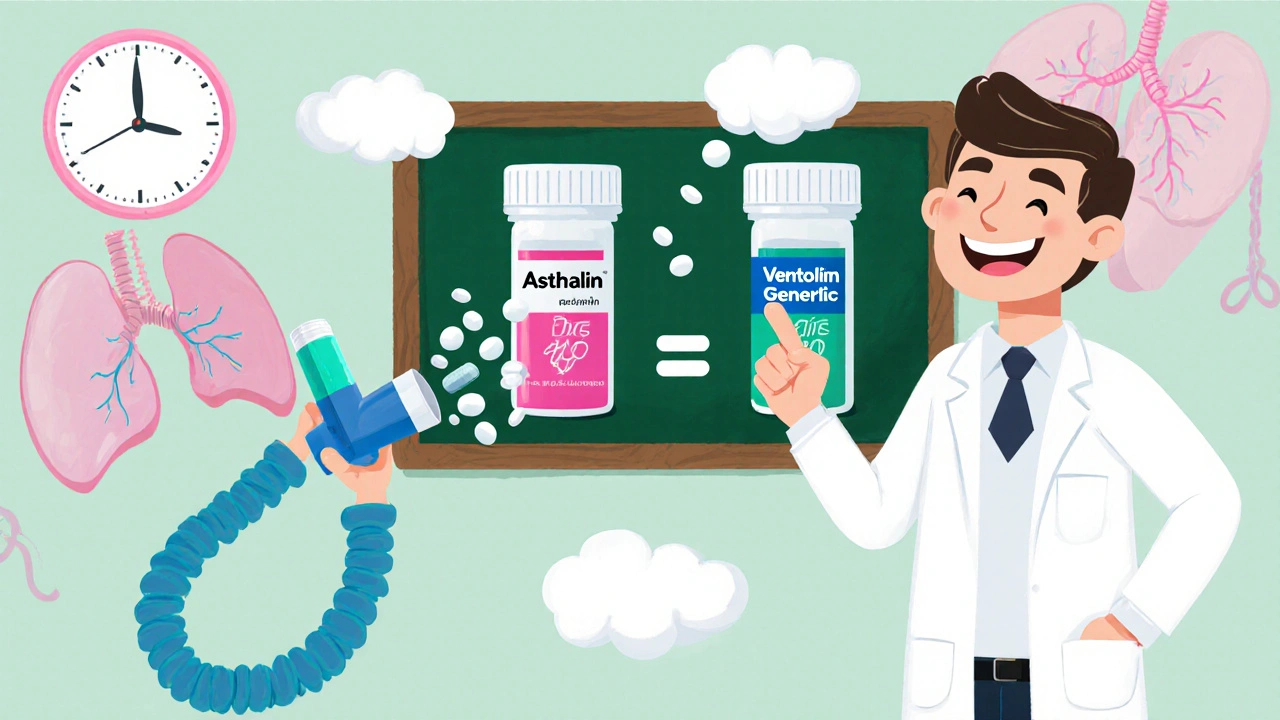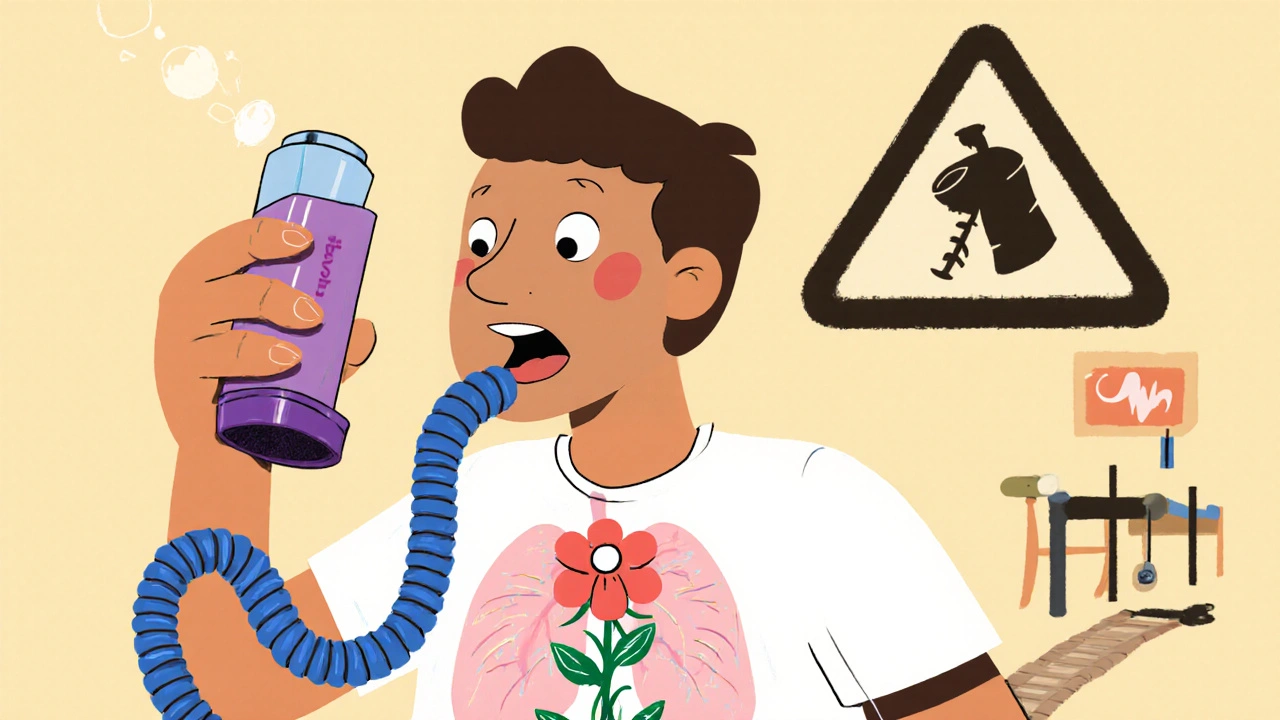
Asthma Inhaler Cost Calculator
Your Current Situation
If you’ve been prescribed an Asthalin inhaler, you’re likely managing asthma or COPD. You know how critical it is to have quick relief when your breathing gets tight. But maybe you’ve noticed the price going up, or your pharmacist suggested another brand. Or maybe you’re just wondering: Asthalin works, but are there better options? The truth is, Asthalin isn’t the only inhaler out there that delivers salbutamol - and not all alternatives are created equal.
What’s in Asthalin Inhaler?
Asthalin inhaler contains salbutamol sulfate, a short-acting beta-2 agonist (SABA). That’s a fancy way of saying it relaxes the muscles around your airways, opening them up within minutes. Each puff delivers 100 micrograms of salbutamol. It’s fast, effective, and has been used for over 50 years. Most people feel relief in 5 to 10 minutes, and the effect lasts 4 to 6 hours.
It’s not a preventive inhaler. You don’t use Asthalin every day to keep symptoms away. You use it when you’re wheezing, coughing, or feeling short of breath. Think of it as your emergency tool - like a fire extinguisher for your lungs.
Why People Look for Alternatives
There are three main reasons people ask about alternatives to Asthalin:
- Cost: Asthalin can be expensive without a subsidy, especially if you’re using it often.
- Availability: Sometimes pharmacies run out, or the brand isn’t stocked in your region.
- Side effects: Some users report tremors, rapid heartbeat, or nervousness - not everyone tolerates it well.
But here’s the key point: most alternatives aren’t different drugs. They’re just different brands of the same active ingredient - salbutamol. The real differences come down to delivery, cost, and how your body responds.
Common Alternatives to Asthalin Inhaler
Here are the most widely used alternatives available in Australia and globally:
| Brand Name | Active Ingredient | Dose per Spray | Typical Cost (AUD per 200 doses) | Available as Spacer Compatible? |
|---|---|---|---|---|
| Asthalin | Salbutamol sulfate | 100 mcg | $25-$35 | Yes |
| Ventolin | Salbutamol sulfate | 100 mcg | $28-$38 | Yes |
| Salbutamol Generic | Salbutamol sulfate | 100 mcg | $15-$22 | Yes |
| Bricanyl | Terbutaline sulfate | 500 mcg | $30-$40 | Yes |
| Airomir | Salbutamol sulfate | 100 mcg | $20-$28 | Yes |
Let’s break down what matters most in this table.
Asthalin vs Ventolin: Is There a Real Difference?
Many people think Ventolin is "stronger" or "better" than Asthalin. It’s not. Both contain the same dose of salbutamol sulfate - 100 mcg per puff. The only differences are the brand name, the packaging, and the price.
Ventolin is the original brand developed by GlaxoSmithKline. Asthalin is a generic version made by Cipla, an Indian pharmaceutical company. Both meet the same Australian Therapeutic Goods Administration (TGA) standards. In clinical trials, there’s no measurable difference in effectiveness or speed of action.
Some users report Ventolin feels "smoother" when inhaled. That’s likely because of the propellant blend or the valve design - not the medicine itself. If you’ve been using Asthalin without issues, switching to Ventolin won’t give you better control. But if cost is a problem, Asthalin saves you $10-$15 per inhaler.

Generic Salbutamol: The Smart Budget Choice
Generic salbutamol inhalers are identical in active ingredient and dosage to Asthalin and Ventolin. They’re just made by different manufacturers - often under contract for pharmacies or public health programs.
In Australia, generic versions are listed on the Pharmaceutical Benefits Scheme (PBS), meaning eligible patients pay as little as $30 for a 200-dose inhaler. Even without PBS, they’re often the cheapest option on pharmacy shelves.
One thing to watch: some generics use different propellants. Most now use HFA (hydrofluoroalkane), which is environmentally safer than the old CFCs. But if you’ve had trouble with a particular generic brand - say, it coughs more or doesn’t feel as smooth - try another. The medicine is the same, but the delivery can vary slightly.
Bricanyl: A Different Drug, Same Goal
Bricanyl contains terbutaline, not salbutamol. It’s also a SABA, but it works a little differently. Terbutaline has a longer half-life, meaning it might last a bit longer - up to 6 hours for some people. But it doesn’t kick in as fast as salbutamol. For acute attacks, salbutamol is still the gold standard.
Bricanyl is often used for long-term control in some countries, but in Australia, it’s mostly reserved for patients who can’t tolerate salbutamol. If you get shaky hands or a racing heart with Asthalin, your doctor might suggest trying Bricanyl. But don’t switch on your own. Terbutaline can cause more muscle cramps and has a higher risk of low potassium levels if overused.
Airomir: The Quiet Contender
Airomir is another salbutamol inhaler, made by a UK-based company. It’s less common in Australia than Asthalin or Ventolin, but it’s gaining traction because it’s affordable and reliable.
One advantage: Airomir’s valve design produces a finer mist, which some users find easier to coordinate with breathing. If you’ve struggled with timing your puff - especially with older adults or kids - this might help. It’s also approved for use with spacers, just like the others.

When Alternatives Don’t Work
Some people switch inhalers and still feel short of breath. That’s not a brand issue - it’s a sign your asthma isn’t well controlled.
If you’re using your rescue inhaler more than twice a week (not counting exercise), you need a preventer inhaler. That’s usually a low-dose corticosteroid like fluticasone or budesonide. Rescue inhalers treat symptoms. Preventers treat the inflammation causing them.
Using only salbutamol inhalers long-term increases your risk of severe asthma attacks. Studies show people who rely solely on SABAs have a 2.5 times higher chance of hospitalization. Don’t wait for an emergency. Talk to your doctor about adding a daily preventer if you haven’t already.
Spacer Use: The Hidden Game-Changer
It doesn’t matter if you’re using Asthalin, Ventolin, or a generic. If you’re not using a spacer, you’re wasting up to 80% of your dose.
A spacer is a plastic tube with a mask or mouthpiece. It holds the puff after you spray it, giving you time to inhale slowly. This means more medicine reaches your lungs and less sticks to your throat - which reduces hoarseness and thrush.
Spacers are free or low-cost at most Australian pharmacies. Kids, elderly people, and anyone with coordination issues benefit the most. Even if you’re young and healthy, using a spacer makes your inhaler work better. It’s not optional - it’s essential.
What to Do Next
Here’s a simple plan if you’re unsure about your inhaler:
- Check your current inhaler’s expiry date. Old inhalers lose potency.
- Ask your pharmacist if a generic salbutamol is available and covered by PBS.
- If you’re using your rescue inhaler more than twice a week, book a review with your GP.
- Ask for a spacer if you don’t have one - and learn how to use it properly.
- Don’t switch brands just because it’s cheaper. Try one alternative at a time and monitor how you feel.
The best inhaler is the one you’ll use correctly - and that’s often the cheapest one you can get without compromising safety.
Is Asthalin the same as Ventolin?
Yes, Asthalin and Ventolin contain the same active ingredient - salbutamol sulfate - at the same dose (100 mcg per puff). The only differences are the brand name, packaging, and price. Both work equally well for relieving asthma symptoms. Ventolin is the original brand; Asthalin is a generic version. Switching between them won’t change your symptom control if you’re using them correctly.
Can I switch from Asthalin to a cheaper generic?
Absolutely. Generic salbutamol inhalers are just as effective as branded versions. They’re tested by the TGA to meet the same safety and performance standards. Many Australians save $10-$20 per inhaler by switching. Just make sure the generic is HFA-based (not CFC), and use a spacer to ensure you’re getting the full dose.
Why does my inhaler sometimes feel less effective?
If your inhaler feels less effective, it could be because you’re not using a spacer, your technique is off, or the inhaler is nearly empty. Most inhalers have a counter, but if yours doesn’t, track how many puffs you’ve used. A standard inhaler has 200 puffs. Once you’re past 180, it may not deliver the full dose. Also, if you’re using it more than twice a week, your asthma may need a preventer inhaler - not a stronger rescue inhaler.
Is Bricanyl better than Asthalin for COPD?
Bricanyl (terbutaline) is sometimes used for COPD, but it’s not necessarily better than Asthalin. Salbutamol (in Asthalin) works faster and is preferred for acute flare-ups. Terbutaline lasts longer but takes more time to kick in. For most COPD patients, salbutamol remains the first-line rescue inhaler. Your doctor might suggest Bricanyl only if you have side effects from salbutamol, like tremors or a fast heartbeat.
Do I need a prescription for Asthalin or its alternatives?
In Australia, salbutamol inhalers like Asthalin, Ventolin, and generics are prescription-only. You can’t buy them over the counter. This ensures you’re getting proper asthma management. If you’re using one regularly, your doctor should review your condition every 6-12 months to check if you need a preventer inhaler too.
Final Thought: It’s Not About the Brand - It’s About Control
The best inhaler isn’t the most expensive one. It’s the one you use correctly, consistently, and with a spacer. Whether it’s Asthalin, Ventolin, or a generic, the medicine inside is the same. What changes your life isn’t the brand name - it’s knowing when to use it, when to call your doctor, and when to add a preventer. Don’t just chase the cheapest option. Chase the one that helps you breathe without fear.

 Health and Wellness
Health and Wellness
Dr. Alistair D.B. Cook
October 29, 2025 AT 18:16Wait-so you’re telling me Ventolin and Asthalin are the SAME THING?? I’ve been paying $35 for Ventolin for YEARS thinking it was ‘premium’… and now I find out I could’ve been saving $10 per inhaler?? I feel like I’ve been scammed by Big Pharma marketing… 😭
Ashley Tucker
October 30, 2025 AT 12:26Let me guess-you’re one of those people who thinks ‘generic’ means ‘cheap junk.’ In America, we don’t settle for Indian-made inhalers. If it ain’t made in the USA, it ain’t trustworthy. I’d rather pay double and know my medicine wasn’t packed in a basement in Mumbai.
Allen Jones
November 1, 2025 AT 02:34YOU KNOW WHAT THEY’RE NOT TELLING YOU?? The propellants in these inhalers? They’re laced with tracking microchips. HFA isn’t just ‘environmentally safe’-it’s a surveillance tool. The FDA, WHO, and Big Pharma are all in on it. Your inhaler doesn’t just open your airways-it sends your breathing patterns to the cloud. 😳 I’ve been using a spacer… but I spray into a plastic bag first now. Just in case.
jackie cote
November 1, 2025 AT 05:08If you're using your rescue inhaler more than twice a week, see your doctor. That’s not a suggestion-it’s medical protocol. Your lungs aren’t a fire alarm you keep pulling for fun. Preventers exist for a reason. Don’t wait for the ER to teach you a lesson.
ANDREA SCIACCA
November 3, 2025 AT 04:58THEY WANT YOU TO THINK IT’S JUST A BRAND THING… but it’s not. It’s a psyop. The same salbutamol? Sure. But the *vibrations* in the aerosol? The *energy frequency* of the propellant? It’s tuned to keep you dependent. I switched to Bricanyl and suddenly I felt… lighter. Not just physically. Spiritually. The universe aligned. I cried. You will too.
Camille Mavibas
November 4, 2025 AT 03:33Just switched to generic salbutamol last month 🙌 Saved $20 and my lungs didn’t even notice. Pro tip: use a spacer. It’s like giving your lungs a VIP pass. 🎟️💨 Also, your pharmacist probably has free ones. Just ask. No shame. 💙
Shubham Singh
November 4, 2025 AT 11:03I’ve been using Asthalin for 12 years. My father used it. My grandfather used it. In India, we don’t chase brands. We chase results. If it works, it’s sacred. Ventolin? It’s just Asthalin with a fancy label. Why pay more for the same relief? The real tragedy is people who don’t use spacers. You’re wasting medicine and money. Shame.
Hollis Hamon
November 5, 2025 AT 17:56I appreciate how thorough this breakdown is. It’s rare to see someone explain the science without pushing a brand. I’ve had patients switch from Ventolin to generic and panic-thinking they’re getting ‘less medicine.’ It’s not about the label. It’s about technique. And yes, spacers are non-negotiable. I hand them out like candy.
Adam Walter
November 6, 2025 AT 14:58Let’s get real: inhalers are the ultimate ‘invisible tech’-you don’t see the chemistry, you just feel the relief. But here’s the kicker: the difference between Asthalin and Airomir isn’t in the salbutamol-it’s in the *aerosol dynamics*. Airomir’s valve produces a finer mist, which means less throat deposition. That’s why some folks swear by it. It’s not placebo-it’s physics. And if you’re using a spacer? You’re already winning. 🏆
Gurupriya Dutta
November 7, 2025 AT 08:06Thank you for writing this. I’ve been scared to switch from Ventolin because I thought it was ‘better.’ But now I feel confident trying the generic. I’ll ask my pharmacist about the spacer too. I never realized how much I was wasting. This post made me feel less alone.
Michael Lynch
November 9, 2025 AT 01:20My dad used to say, ‘The best tool is the one you actually use.’ He’d forget his inhaler, then blame the brand. Turns out, he just hated the taste. Switched to Airomir-less bitter. Used a spacer. Now he’s breathing easy. No magic. Just smart habits.
caroline howard
November 10, 2025 AT 18:39Wow. I’ve been using Asthalin for years and never even thought to ask about spacers. I just thought I was bad at using it. Turns out I was just using it wrong. Time to grab one from the pharmacy. Thanks for the nudge. 🤗